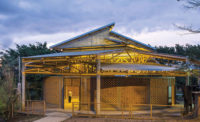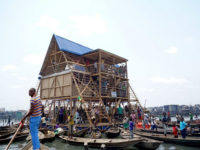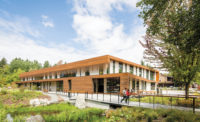A new school in the sprawling Nairobi slum of Kibera stands in striking contrast to the informal settlement that surrounds it: the building’s white polycarbonate roof and colorful steel-pipe structure suggest a jungle gym more than an educational facility, and give it a profile that’s easy to spot among thousands of weathered metal roofs. Designed by Madrid-based SelgasCano and Boston-based helloeverything, the fanciful building replaces a dilapidated school that formerly occupied the site.
José Selgas and Lucía Cano were introduced to Kibera when they visited Kenya for a different project, a vaccination clinic in the Turkana region they designed in collaboration with their students at MIT. So when the Louisiana Museum in Denmark approached the architects and their former students (who had since founded helloeverything) in late 2014 and asked them to recreate the Turkana clinic as a pavilion for their campus, the architects decided to use the commission as an opportunity to model a new project instead. This would not just be a folly but a structure that could be disassembled and transported elsewhere, to be put to use after the exhibition was over. For the project, the team used the same scaffolding components they had employed in Turkana—materials similar to those used in domestic constructions across Africa—to create their pavilion and future primary school in Kibera. The firms coordinated the replacement with Nairobi-based architect Abdul Fatah Adam and the Kibera Hamlets community organization.
In order to fit the required amount of classroom space onto the tiny site, the architects followed the two-level construction of the previous school, but, instead of having a shaky ladder connecting the levels, they built a broad staircase. A double-sized classroom and a balcony on the second floor create a range of different learning environments, while a covered courtyard below can host activities involving greater numbers. Crowned by translucent corrugated polycarbonate sheets—whose haphazard-looking arrangement mimics that of neighboring metal roofs—the facility is drenched in light, while also spared significant heat gain. Two of helloeverything’s principals supervised construction, while all workers and craftsmen came from the neighborhood around the site.
Helloeverything partner Austin Smith says the team wanted to tap into the expressive and even playful potential of commonly used scaffolding materials, but the components also provided a functional advantage. Rebuilding the school proved harder than anticipated—the site was off-level, for example, but the versatility of the materials allowed for easy on-the-fly adjustments.
“We weren’t trying to express anything particular with the form—we just wanted to improve on the school that was there however we could,” said Selgas. “There was no budget for the materials, which, in the end, led to a building that looks very different, almost iconic, something people in the neighborhood can recognize.”
Not only did the pipe-and-polycarbonate-panel kit of parts rise to the challenge during the construction process, it also proved reliable during transportation: the simple pieces were easy to dismantle and pack up. The only hiccups in the shipping process, says Smith, were on the legal side: the container was held by the Kenyan port authority for weeks because no one could figure out how to classify it; it’s not every day you ship a building across continents, the architects noted.











Post a comment to this article
Report Abusive Comment